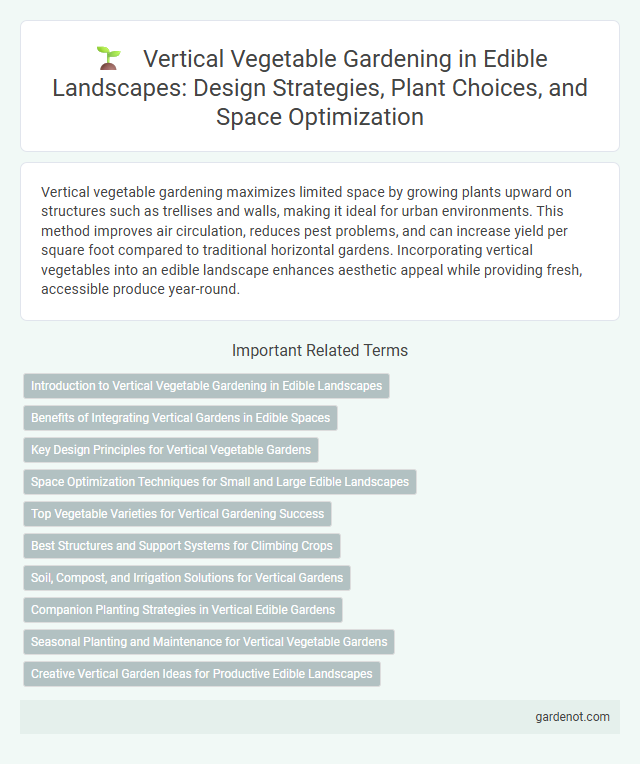Vertical vegetable gardening maximizes limited space by growing plants upward on structures such as trellises and walls, making it ideal for urban environments. This method improves air circulation, reduces pest problems, and can increase yield per square foot compared to traditional horizontal gardens. Incorporating vertical vegetables into an edible landscape enhances aesthetic appeal while providing fresh, accessible produce year-round.
Introduction to Vertical Vegetable Gardening in Edible Landscapes
Vertical vegetable gardening maximizes space by growing plants upward using structures like trellises, cages, or walls, ideal for urban and small garden environments. This method enhances yield per square foot by supporting climbing vegetables such as tomatoes, beans, and cucumbers, improving air circulation and reducing soil-borne diseases. Integrating vertical vegetables into edible landscapes promotes sustainable food production while creating visually appealing green spaces.
Benefits of Integrating Vertical Gardens in Edible Spaces
Integrating vertical gardens in edible landscapes maximizes limited urban space by allowing the cultivation of a diverse range of vegetables on walls and structures. Vertical vegetable gardens improve air quality, reduce urban heat, and enhance biodiversity while providing fresh, homegrown produce year-round. This sustainable gardening method also minimizes soil-borne pests and diseases, leading to healthier plants and higher yields.
Key Design Principles for Vertical Vegetable Gardens
Vertical vegetable gardens maximize limited space by incorporating sturdy support structures like trellises and cages that promote healthy plant growth and easy access. Optimal sunlight exposure and proper spacing between plants ensure adequate airflow, reducing the risk of disease and enhancing productivity. Integrating efficient irrigation systems and selecting lightweight, nutrient-rich growing media improve water retention and nutrient delivery, fostering robust vegetable development in vertical setups.
Space Optimization Techniques for Small and Large Edible Landscapes
Vertical vegetable gardening maximizes space by utilizing structures like trellises, pallets, and vertical planters, enabling efficient growth of crops such as tomatoes, cucumbers, and beans in both small urban gardens and expansive edible landscapes. Incorporating tiered planter boxes and hanging baskets enhances plant density while maintaining accessibility for maintenance and harvest. Strategic selection of climbing and vining vegetable varieties optimizes sunlight exposure and air circulation, promoting higher yields per square foot.
Top Vegetable Varieties for Vertical Gardening Success
Vertical gardening thrives with vegetable varieties like cherry tomatoes, pole beans, cucumbers, and lettuce, which adapt well to limited space and vertical support. These vegetables optimize yield in compact areas by growing upwards, making them ideal for edible landscapes. Selecting fast-growing, hardy plants such as Swiss chard and zucchini enhances productivity and maximizes vertical garden success.
Best Structures and Support Systems for Climbing Crops
Vertical vegetable gardens thrive with sturdy trellises, cages, and stakes that provide optimal support for climbing crops like peas, beans, and cucumbers. Materials such as bamboo, metal mesh, and coated wire ensure durability and proper airflow, reducing disease risk and maximizing yield. Incorporating adjustable supports allows for plant growth flexibility and ease of harvesting, enhancing overall productivity in edible landscapes.
Soil, Compost, and Irrigation Solutions for Vertical Gardens
Vertical vegetable gardens thrive with well-aerated soil mixes enriched with organic compost to enhance nutrient retention and support healthy root development. Implementing drip irrigation systems ensures efficient water delivery directly to plant roots, minimizing waste and promoting sustainable growth in limited spaces. Incorporating moisture-retentive substrates combined with high-quality compost boosts soil fertility while optimizing water management for vertical farming success.
Companion Planting Strategies in Vertical Edible Gardens
Companion planting strategies in vertical vegetable gardens optimize space and enhance biodiversity by pairing crops that mutually benefit growth, such as climbing beans with maize or tomatoes with basil. Incorporating vertical structures like trellises or living walls allows efficient use of sunlight and air circulation, promoting healthier plants and reducing pest incidence. Strategic plant combinations improve nutrient uptake and yield, making vertical edible landscapes both productive and sustainable.
Seasonal Planting and Maintenance for Vertical Vegetable Gardens
Vertical vegetable gardens require strategic seasonal planting to optimize growth cycles and maximize yield throughout the year. Selecting cool-season crops like lettuce and spinach in spring and fall, and warm-season vegetables such as tomatoes and peppers in summer ensures continuous productivity. Regular maintenance, including pruning, watering, and nutrient management, is essential to support healthy vertical growth and prevent pest infestations.
Creative Vertical Garden Ideas for Productive Edible Landscapes
Creative vertical garden ideas for productive edible landscapes include using tiered planters, wall-mounted pockets, and trellis systems to maximize space and yield. Incorporating vertical structures like repurposed pallets or hanging garden pockets allows for efficient growth of vegetables such as tomatoes, beans, and leafy greens in small urban areas. Optimizing sunlight exposure and irrigation through drip systems enhances plant health and increases overall productivity in vertical vegetable gardens.
Vertical vegetable Infographic

 gardenot.com
gardenot.com